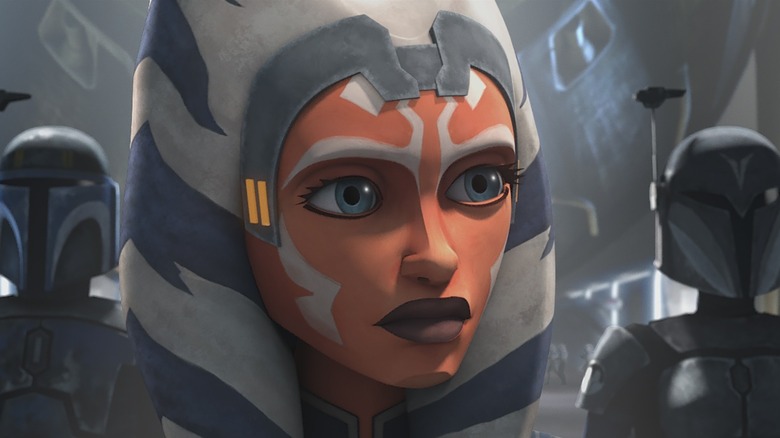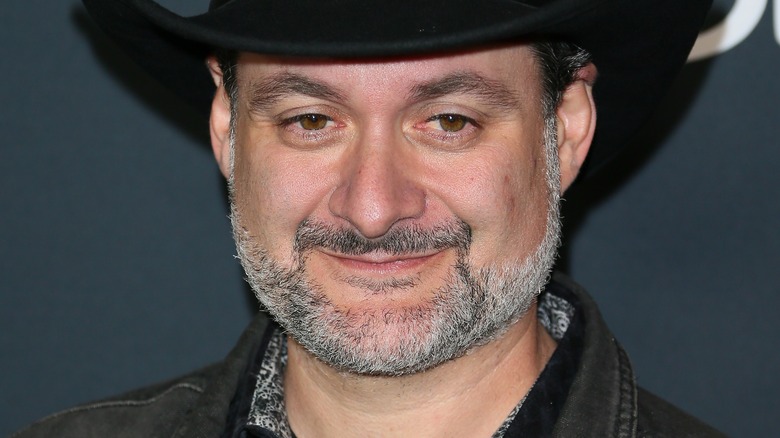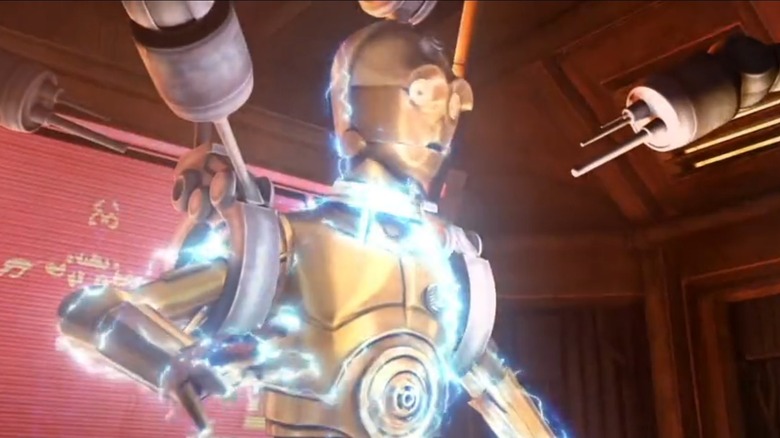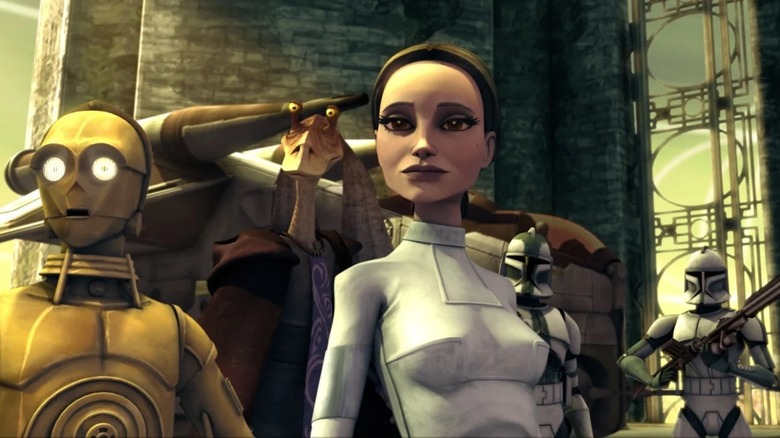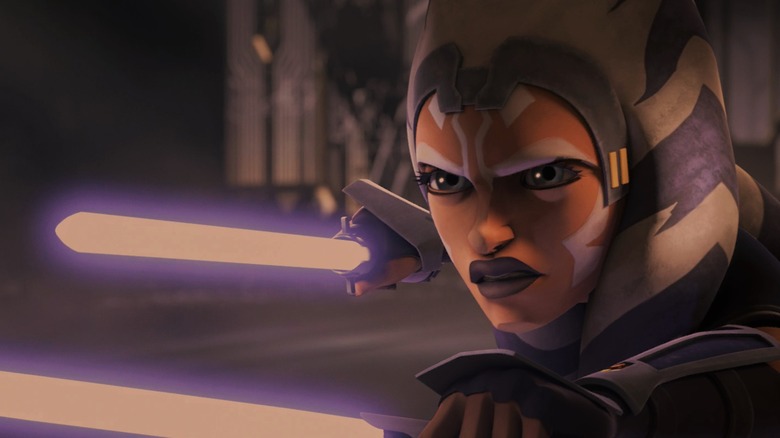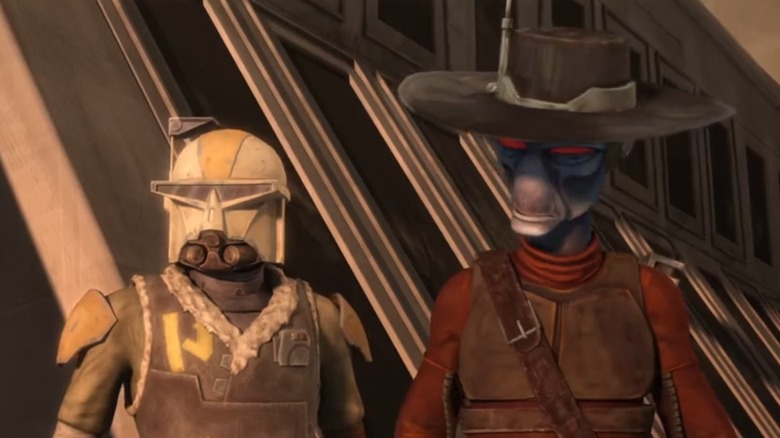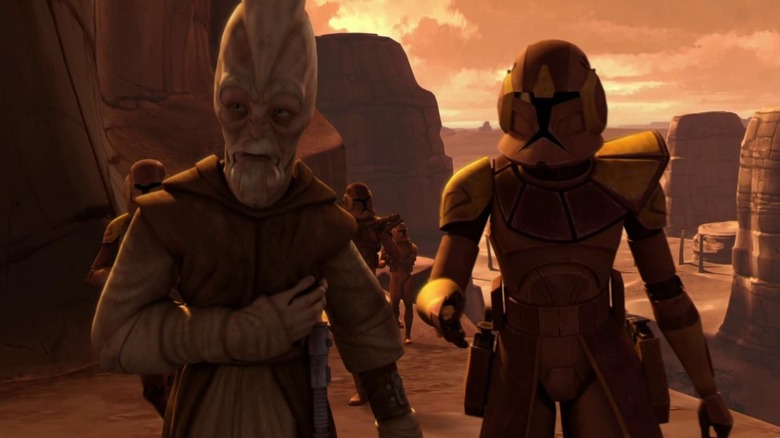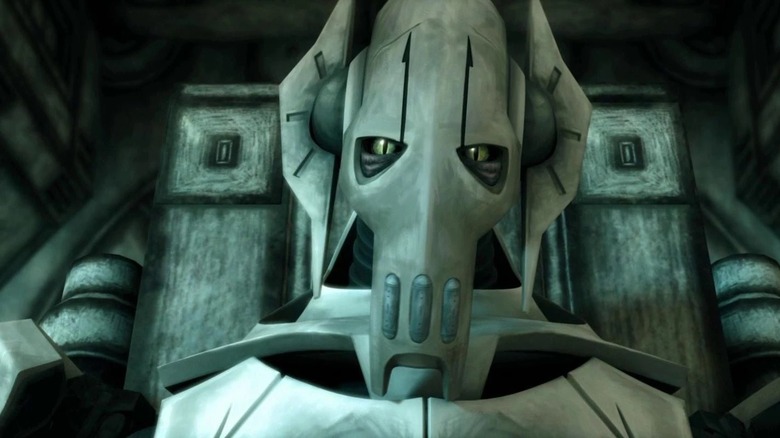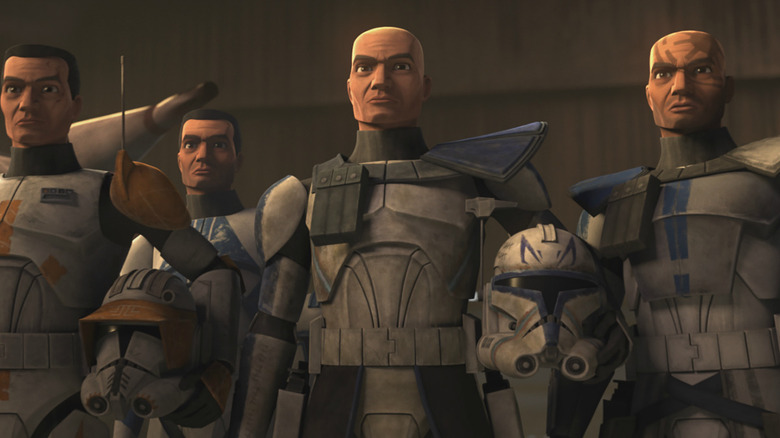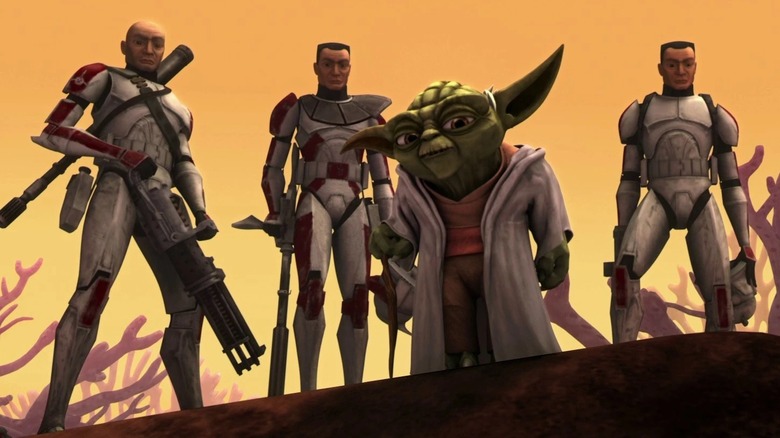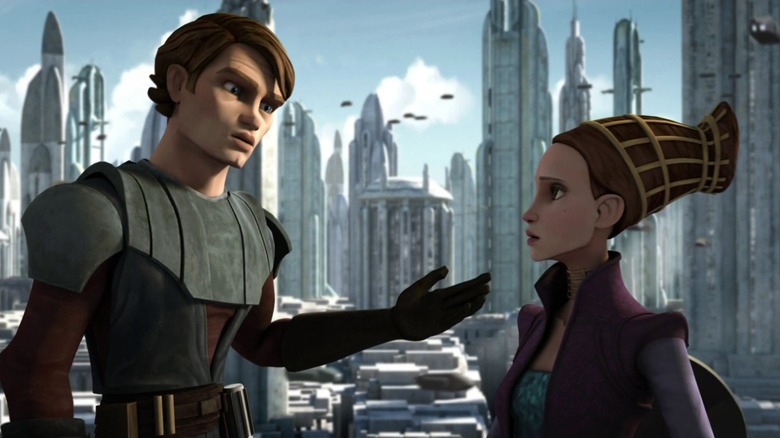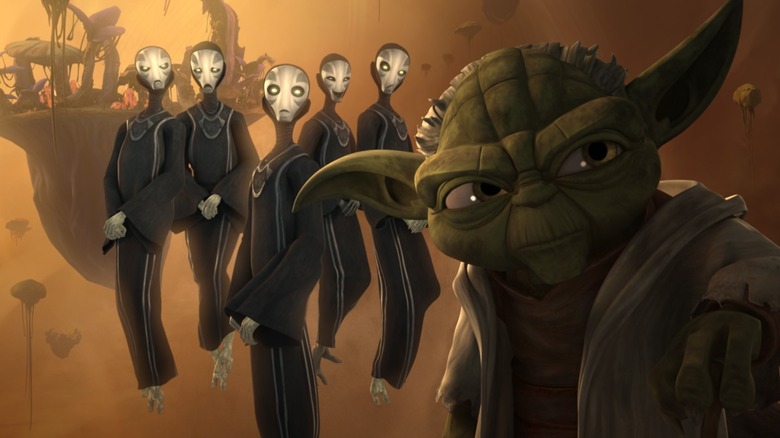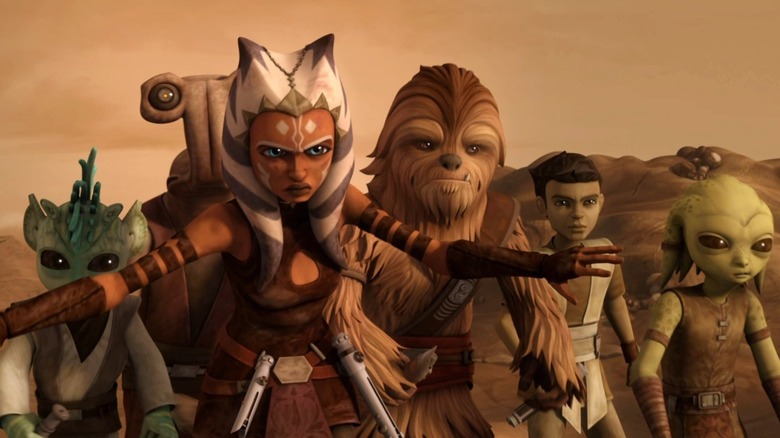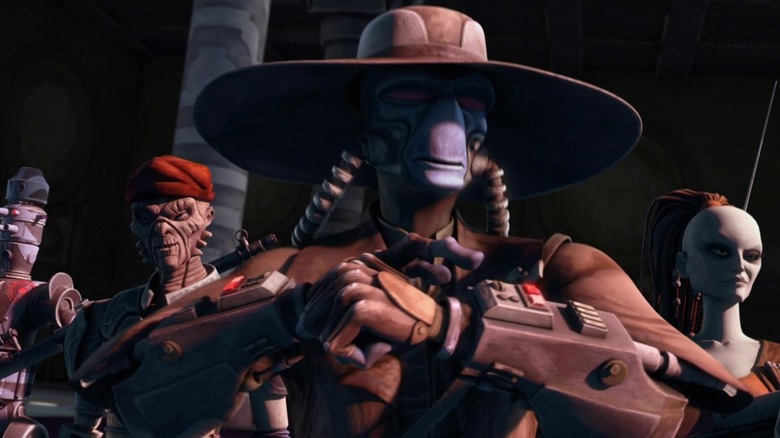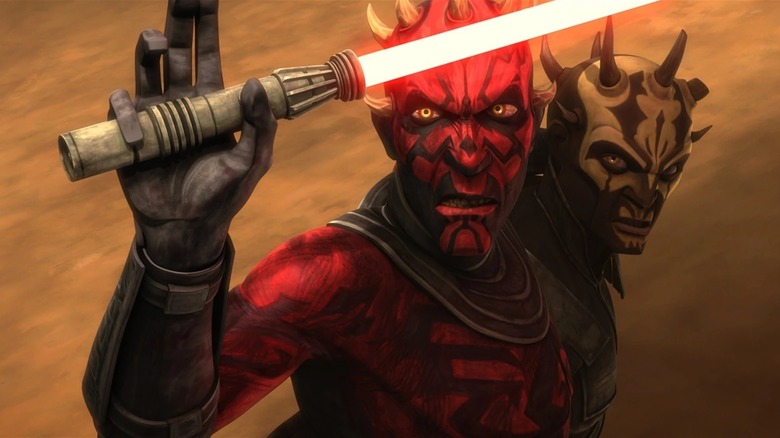The Fascinating History Behind Star Wars: The Clone Wars
We may receive a commission on purchases made from links.
Running for seven seasons and 133 episodes, "Star Wars: The Clone Wars" was an expansive TV show that broke new ground for the kinds of stories that could be told within the "Star Wars" universe. In its run, "The Clone Wars" managed to tell stories that spanned from political dramas to homages to classic monster movies to even a multi-episode arc with individual episodes that paid tribute to everything from "Black Hawk Down" to "Aliens." This galaxy far, far away is limitless in size, and "The Clone Wars" constantly delivered a string of narratives that capitalized on all the storytelling potential in this franchise. It's no wonder this program has garnered such a significant following from viewers of all ages that see no signs of slowing down or shrinking in size.
Given how beloved "The Clone Wars" ended up being and its impact on "Star Wars" as a franchise, it can be hard to remember that the various episodes of this TV show didn't show up out of the blue. Years of effort from countless artists went into this production, which is blatantly apparent in the rich and fascinating history behind "Star Wars: The Clone Wars." Details like what kind of creative freedom the writers of "The Clone Wars" had, or the initial difficulty of getting this show on the air, reflect all the creative passion and energy that went into a show that changed "Star Wars" forever.
How Dave Filoni got roped into The Clone Wars
The first episode of the Disney+ documentary "Disney Gallery: The Mandalorian" doesn't just reflect on the origins of the inaugural live-action "Star Wars" show. Dave Filoni, a key creative force on "The Mandalorian," also details how he got immersed into the world of "Star Wars" in the first place by bagging the position of showrunner for "Star Wars: The Clone Wars." It wasn't an easy road to this job. In this "Disney Gallery" episode, Filoni recounts how, back in 2005, George Lucas had received a call from a Lucasfilm Animation representative. This person revealed to Filoni recommended him highly to Lucasfilm Animation brass as someone to reach out to for a key job on "The Clone Wars."
The prospect of working on a "Star Wars" TV show sounded like such an impossible concept to Filoni, a lifelong "Star Wars" devotee, that he initially thought the offer was a prank. But soon, Filoni was offered a meeting with George Lucas to discuss the job, an interaction Filoni was certain would not go anywhere. However, intrigued at the concept of having an anecdote he could impress other "Star Wars" geeks with, he went into the meeting and discussed with Lucas what "The Clone Wars" could be. Something must've gone very right in that meeting, because Filoni subsequently got "The Clone Wars" gig and become a critical behind-the-scenes player in "Star Wars" media for decades to come.
The original focus of The Clone Wars
The initial "Star Wars: The Clone Wars" episodes focus on who you'd expect an animated series set in the prequel trilogy era of "Star Wars" to highlight. Anakin Skywalker and Obi-Wan Kenobi are the leads, while the new kid-surrogate character Ahsoka Tano also gets to shine. Jedi previously seen in the background like Plo Koon and Kit Fisto also have starring roles. As early as the tail end of Season 1, it started to become common for newly created characters like Captain Rex and Cad Bane to anchor entire episodes, with the fifth episode of this season, "Rookies," helping to normalize this concept. But at the very start, Tano was the only totally new character regularly highlighted in a show heavy on familiar faces.
However, the book "The Art of Star Wars: The Clone Wars" indicates that there were originally plans to make new characters the stars from the get-go. Initially, Filoni floated the idea that "The Clone Wars" would largely center on a ragtag group of aliens and humans, including a padawan and her Jedi Master, none of them previously established figures. This would've been done to ensure that "The Clone Wars" didn't interfere with previously established continuity. George Lucas insisted that "The Clone Wars" center itself on the likes of Anakin Skywalker, though some of these initial ideas, namely the plucky padawan, would make their way into the final version of the show.
Which beloved Star Wars characters were originally off limits
Part of why people love the "Star Wars" universe so much is how vast it is. There are countless planets, species, and characters, which ensures limitless opportunities for narratives within this saga. Anybody tasked with creating a piece of "Star Wars" media would doubtlessly be enthralled by all this potential. However, the "Star Wars: The Clone Wars" crew weren't given total free rein at first: George Lucas established some characters as off limits to the TV program when it was just getting off the ground.
Talking to TheForce.net, writer Henry Gilroy revealed that Lucas had a mandate at the start that "The Clone Wars" couldn't use Han Solo, Chewbacca, Boba Fett, or Jabba the Hutt. There was also an insistence from Lucas that "The Clone Wars" avoid planets that had already been explored in the movies. However, these restrictions eased quite quickly, with Lucas immediately reversing his position on Jabba the next time he talked to Gilroy. Seeing all the possibilities of "The Clone Wars" and its narratives eased Lucas' mandates and ensured this TV show could play around with some of the most beloved figures in the "Star Wars" mythos.
Why Ahsoka was important for The Clone Wars
Today, Ahsoka Tano is viewed by "Star Wars" geeks of all ages as an essential part of the franchise's mythology. Her live-action debut in "The Mandalorian" was greeted with widespread acclaim, and Tano has also become beloved enough to secure her own live-action spinoff show, "Ahsoka," on Disney+. But years ago, Tano wasn't a surefire hit with viewers. Instead, she was the most prominent new figure in "Star Wars: The Clone Wars," a fresh addition to the mythology that was greeted with uncertainty by many. What's now viewed as vital to "Star Wars" lore was once seen with much less favorable eyes.
But from the very beginning, Dave Filoni and company were convinced of all the potential Tano had as a character. Talking to Skewed & Reviewed, Filoni noted that part of why Ahsoka was viewed as such an important character in "The Clone Wars" was the way she could provide a critical contrast to her master, Anakin Skywalker. George Lucas also chimed in to note that Tano was fulfilling the role of a young ordinary person getting swept up in something bigger, an archetype "Star Wars" had utilized successfully in the past with characters like Luke Skywalker. Tano was viewed as a logical new manifestation of this kind of character. Right from the start, Ahsoka Tano was set up as somebody of critical importance to the world of "Star Wars."
How much creative freedom the Clone Wars crew had
Working within a famous established property like "Star Wars" can be as much of a blessing as it is a curse. On one hand, you get to work within beloved mythology rife with storytelling potential that's bound to be seen by audiences. On the other hand, you've also got to deal with the lofty threat of fan expectations. Plus, there's also the fact that many executives and producers want these long-running franchises to just mimic what's worked in the past, which can be restrictive for writers.
Talking to CBR, Dave Filoni noted that the creative team of "The Clone Wars" was very much directed by the vision of George Lucas, to the point that he decided whether or not original ideas for "Clone Wars" episodes from Filoni and fellow writer Henry Gilroy would get onto the show. However, Filoni noted too that Lucas grew more open to approving new ideas for storylines and characters and having less total control over the entire production. This whole experience is just one of countless examples of the struggles of working within a pre-established and famous world for writers and other artists.
How the Clone Wars team tackled violent material
Nobody will ever mistake "Star Wars: The Clone Wars" as something geared exclusively toward adults. This was, after all, still a show aimed at kids that aired on Cartoon Network for most of its life. Still, a delightful aspect of the show was just how grisly, by the standards of animated kids' series, it could be. The show featured everything from Ahsoka Tano slicing off the heads of multiple Mandalorian warriors in one fell swoop to lengthy onscreen torture sequences and Cad Bane shooting a Galactic Senator dead without even looking at his target. Kids came to "The Clone Wars" for the "Star Wars" name but often stayed put of perverse interest in whatever violence the show would sneak in that week.
Talking to Den of Geek, Dave Filoni noted that the tonal precedent set by earlier "Star Wars" films helped guide how dark "The Clone Wars" could get. Titles like "The Empire Strikes Back" or "Revenge of the Sith" made Filoni and company feel comfortable with pushing the boundaries of darkness on the show. Plus, Filoni also noted that "The Clone Wars" occupies one of the bleakest moments in the "Star Wars" saga, a time of turmoil that impacts countless lives. The innate sorrow of this era further justified why this program so often went for such startling moments of brutality.
The initial difficulty in getting The Clone Wars on the air
One would imagine that anytime a new "Star Wars" property goes on the market, it'd be as easy as snapping one's fingers to get it a home. Any new TV show or movie in this franchise is bound to attract some major interest from the expansive "Star Wars" fanbase. What studio or TV network wouldn't want to get in on the ground floor with such an inevitably popular project? However, when George Lucas and company were first shopping around "Star Wars: The Clone Wars," there were massive difficulties in getting TV networks to see all the potential in this program.
In 2007, Lucas noted that networks had a hard time wrapping their head around the idea of "The Clone Wars" since it didn't fit into their preconceived boxes for what could be successful. While there was a long track record of "Star Wars" properties being hits, the same wasn't true for darker action-oriented animated kids' TV. With "The Clone Wars" being a bit intense for youngsters yet still having an all-ages appeal, it struggled to click with TV executives used to more standard small-screen programming. Thankfully, these initial problems vanished once Cartoon Network agreed to air the program. The record-shattering ratings for the first episode of "The Clone Wars" proved there was indeed an audience for this program.
The last-minute nature of the Clone Wars movie
"The Clone Wars" didn't begin on the small screen — instead, it technically began on August 15, 2008, with the theatrical movie "Star Wars: The Clone Wars." This production was comprised of four separate episodes of the TV show showcasing the first missions Anakin Skywalker and Ahsoka Tano embarked on together. Supporting characters included everyone from Jabba the Hutt to C-3PO to Asajj Ventress, with the wide array of individuals in this narrative offering a tease for the swarm of characters people could expect to see in the TV show.
The concept of kicking off the show in this manner originated with George Lucas, whose reasoning was quite simple. Talking to Entertainment Weekly, Lucas discussed how impressed he was when he first saw the quality of the animation produced for "The Clone Wars," coming away convinced that it should be experienced on the big screen. Going for a theatrical launchpad for "The Clone Wars" was a massive sign of confidence in the TV show from Lucas. Unfortunately, the feature was critically reviled upon its release, with many commenting that its origin as a collection of TV episodes strung together feels awkwardly apparent.
The short-lived plan to rerun Clone Wars on TNT
While "Star Wars: The Clone Wars" initially aired new episodes on Cartoon Network, Turner Broadcasting also picked up the show with plans to play reruns on TNT. This signaled that "The Clone Wars" wasn't intended to be just for kids and reflected Turner's hopes that the show would be successful enough to flourish on two networks.
In February 2009, just four months after it premiered on Cartoon Network, TNT aired a pair of "Clone Wars" episodes right after an NBA All-Star game. It was a high-profile launch for the program on the network and reinforced how much confidence execs had. However, the show's presence on TNT wouldn't last long. It was initially planned to regularly play on Wednesday nights at 10:00 PM, but by March 2009, reports began emerging that TNT had stopped airing reruns of "The Clone Wars." The show never made a return to the network, and TNT executives never commented on the reason for its abrupt departure from the schedule.
The wardrobe upgrades for the third season
With its third season, "Star Wars: The Clone Wars" opted to upgrade the costumes for its three most pivotal characters, Anakin Skywalker, Ahsoka Tano, and Obi-Wan Kenobi. The trio were given new attire as a way of signaling the passage of time, specifically in regards to "The Clone Wars" inching ever closer to the time period depicted in "Revenge of the Sith." This film inspired the new looks for Skywalker and Kenobi, while Tano, at the time lacking a live-action counterpart to guide her wardrobe, had her new clothes defined by how much she was maturing as a human being.
Tano got the most drastic changes to her character model on "The Clone Wars," which went beyond just altering her wardrobe. She was also depicted as being taller than in previous seasons of the show and now wielding a pair of lightsabers, small but pivotal details reflecting how much she'd grown since first being trained by Anakin Skywalker. The visual alterations for all three characters were especially interesting given how rarely animated TV programs embrace these kinds of alterations. For better and for worse, other animated shows like "The Simpsons" and "Family Guy" use this medium to keep their characters the same indefinitely. But unlike Bart Simpson or Meg Griffin, Ahsoka Tano and her comrades do age, and these "Clone Wars" character design tweaks in Season 3 communicated that beautifully.
The struggles of balancing so many tones in The Clone Wars
Part of the joy of "Star Wars: The Clone Wars" is the wide variety of aesthetics and tones explored in different episodes. One multi-episode arc may focus on the exploits of Jar-Jar Binks, while another string of episodes may concentrate on the grisly actions of Darth Maul and Savage Oppress. You get a little bit of everything in a single season of "Star Wars: The Clone Wars," which can be exhilarating for viewers, but it was a bit of a challenge for the people tasked with creating this show.
Talking to Starwars.com about the show's fifth season, Filoni noted that a key thing he and the other "Clone Wars" writers kept in mind was ensuring there was a constant sense that everything belonged in the "Star Wars" universe. Whether the storylines were wacky or uber-dark, there was an ongoing effort to capture a consistent and recognizable aesthetic that evoked classic "Star Wars" movies to viewers and ensured that all the various "Clone Wars" tones felt like they belonged to the same program. Plus, Filoni noted that the varying tones of individual "Clone Wars" plotlines felt consistent with movies like "Return of the Jedi," which were also all over the map. The "Star Wars" universe was built on tonally flexible stories, and "The Clone Wars" is no exception.
The abandoned younglings spinoff
In the fifth season of "Star Wars: The Clone Wars," viewers were treated to a four-episode arc focusing on a group of six Younglings that had never been seen before in "Star Wars" media: Petro, Katooni, Byph, Ganodi, Zatt, and the adolescent Wookiee Gungi. Their exploits included memorable "Clone Wars" supporting player Hondo Ohnaka and seemed like a pretty normal storyline for "The Clone Wars"; however, there were initially grander plans for these characters involving a spinoff TV show.
In November 2016, Pablo Hidalgo revealed that there were initially plans to remove these four episodes from "The Clone Wars" Season 5 and cobble them together as a movie that would function as a pilot for a spinoff. The episodes premiered as an 80-minute movie called "Young Jedi" at the 2012 edition of Star Wars Celebration, with Hidalgo noting that this presentation functioned as a test screening to see how kids liked the concept. Despite the high-profile debut of this "movie," there's never been an official reason for why the spinoff was abandoned. However, the purchase of Lucasfilm by Disney on the horizon (it occurred just two months after "Young Jedi" was shown to audiences) could've impacted ambitious plans for another animated "Star Wars" program.
The initial abrupt ending of The Clone Wars
In March 2013, "Star Wars: The Clone Wars" wrapped up its fifth season with a normal amount of fanfare. There didn't seem to be anything unusual about this particular season's conclusion until a few days after it aired, when Disney announced that "The Clone Wars" was finished. Five months after the Mouse House purchased Lucasfilm and all of its "Star Wars" properties, Disney was now shutting down "The Clone Wars," despite multiple seasons worth of episodes being in various stages of production at the time.
The reasoning behind canning the program came down to a desire on the part of Disney to focus on other parts of the "Star Wars" mythos. With a trilogy of sequel movies on the horizon, the studio saw "The Clone Wars" as superfluous. This sudden burst of discouraging news was devastating to "The Clone Wars," but the show wasn't quite finished yet. A collection of 13 further episodes were released via Netflix in February 2014, and in the spring of 2020, one final season of the show was produced for Disney+. Meanwhile, characters from "The Clone Wars" continue to play a prominent role in "Star Wars" media, including new live-action projects like "The Mandalorian."
The biggest task in wrapping up The Clone Wars
Not every TV show has the privilege of coming back from the dead. However, years after initially getting canned, "Star Wars: The Clone Wars" managed to return for one final season on Disney+ in 2020. While this collection of episodes couldn't wrap up every storyline introduced in preceding "Clone Wars" seasons, it still added a definitive conclusion to this era of "Star Wars" storytelling. There was a lot of pressure on this momentous season of "The Clone Wars," and nobody was more aware of the stakes than Dave Filoni.
Talking to Deadline, Filoni noted that trying to fit so many key story points into half-hour episodes was one of the biggest challenges of these final "Clone Wars" installments. Knowing that audiences had been looking forward to things like Anakin and Ahsoka reuniting, Filoni knew they had to do these moments justice while also being conscious that there was a very limited amount of time for each story. They couldn't linger on big moments; they had to keep the narrative moving. Juggling the demands of viewers and the stories was a momentous challenge, but one Filoni was very much up for.
